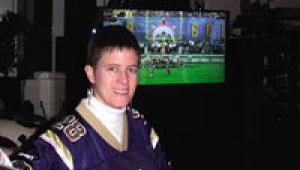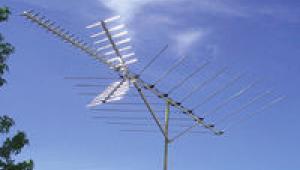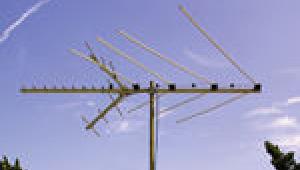In-Your-Face Football
It started out innocently enough, back in January 2000. ABC had concluded a season of Monday Night Football broadcasts in their 720p HDTV format and was putting the icing on the cake with an HD telecast of Super Bowl XXXIV from Atlanta, Georgia. Since I had watched a few of the MNF games in HD, I decided to set up a front projector and an HD monitor and invite some friends and neighbors over to give 'em a taste of sports in high definition. The game turned out to be a big hit. Over 30 folks attended and marveled at the widescreen images from my Sony VPL-VW10HT projector and Princeton AF3.0HD monitor. Never mind that I had to jury-rig an antenna on my rear deck and run coaxial cable into my basement to feed a single Panasonic set-top tuner, then use a video-distribution amplifier to run two component video feeds into my living room and my basement theater. Everyone was amazed at the picture quality and gorged themselves on a feast of wings, subs, pizza, chips, dip, and assorted desserts.
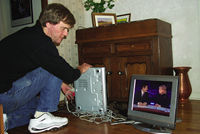 With each passing year, the Super Bowl party has taken on a life of its own. In 2001, a 50-inch Pioneer plasma monitor made its debut in my living room, and I acquired a Sony CRT front projector for my basement theater. Almost 40 people watched the Ravens manhandle the Giants on three HDTV screens, and approximately the same number showed up in 2002 to witness the Patriots' last-minute victory over the Rams on a Fujitsu 50-inch plasma monitor, a Hitachi 42-inch plasma monitor, a Toshiba 34-inch direct-view TV, and the Sony projector.
With each passing year, the Super Bowl party has taken on a life of its own. In 2001, a 50-inch Pioneer plasma monitor made its debut in my living room, and I acquired a Sony CRT front projector for my basement theater. Almost 40 people watched the Ravens manhandle the Giants on three HDTV screens, and approximately the same number showed up in 2002 to witness the Patriots' last-minute victory over the Rams on a Fujitsu 50-inch plasma monitor, a Hitachi 42-inch plasma monitor, a Toshiba 34-inch direct-view TV, and the Sony projector.
How could I top that in 2003? It took some thinking, but I decided to go with an immersive HDTV environment by installing eight different monitors, TVs, and projectors on the first floor of my home and in my basement. Not all of them would be big screens, but each would display either true high definition or something close to it.
The Game Plan
Over the years, I've taken the time to hard-wire cable from my rooftop and attic antennas into several rooms. (No more snaking antenna cables into the basement from the deck.) With this setup, I can watch all nine of my local Philadelphia DTV stations in my basement theater, family room, and living room.
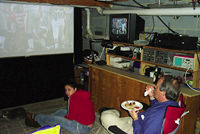 My RF test equipment revealed that I receive a strong signal from WPVI-64 in several areas around my home, including three spots in the kitchen, two in my dining room, and one in my bathroom (of all places). This meant that, as long as I had enough set-top boxes and displays to connect them to, I could easily outdo my 2002 effort. I again planned to use the Toshiba direct-view set and the Sony CRT projector, as well as a Mitsubishi LCD monitor, but what else? My wife Jackie, who can't stand football but tolerates this annual festival of pigskin madness, suggested that I add at least one small TV with a black-and-white image as a throwback and counterpoint to all of the large HD displays. Not a bad idea, and it was certainly easy enough to pull off, but I came up with an even better idea. In addition to the retro TV, why not also place a small LCD TV in the first-floor bathroom? This way, die-hard sports fans wouldn't have to miss one second of the game, and they'd still be watching in high definition.
My RF test equipment revealed that I receive a strong signal from WPVI-64 in several areas around my home, including three spots in the kitchen, two in my dining room, and one in my bathroom (of all places). This meant that, as long as I had enough set-top boxes and displays to connect them to, I could easily outdo my 2002 effort. I again planned to use the Toshiba direct-view set and the Sony CRT projector, as well as a Mitsubishi LCD monitor, but what else? My wife Jackie, who can't stand football but tolerates this annual festival of pigskin madness, suggested that I add at least one small TV with a black-and-white image as a throwback and counterpoint to all of the large HD displays. Not a bad idea, and it was certainly easy enough to pull off, but I came up with an even better idea. In addition to the retro TV, why not also place a small LCD TV in the first-floor bathroom? This way, die-hard sports fans wouldn't have to miss one second of the game, and they'd still be watching in high definition.
The count was up to five displays. I decided to place another LCD monitor next to the coffee-and-tea service area in my kitchen. This HD display wouldn't have any sound—just a picture. Since my family room and dining room are adjacent, I figured that there would be plenty of audio spillover.
Brought to You By . . .
Six displays might sound like a sports fan's dream, but I wasn't done yet. For several months, Ken Tompkins of Optoma had been asking me to look at one of his company's small home theater DLP projectors. I decided to take him up on his offer, and I built a temporary theater in the unfinished portion of my basement, using a spare front-projection screen from my office.
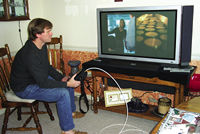 Now the tally was seven displays. While four of them were either on hand or en route, I needed to locate three more. Casual inquiries to a few companies resulted in an emphatic yes from John Taylor, vice president of public relations for Zenith. John committed to contribute an L15V26 15-inch LCD TV (which has a 1,024:768 ED resolution) and a pair of HDV420 ATSC set-top receivers to my project.
Now the tally was seven displays. While four of them were either on hand or en route, I needed to locate three more. Casual inquiries to a few companies resulted in an emphatic yes from John Taylor, vice president of public relations for Zenith. John committed to contribute an L15V26 15-inch LCD TV (which has a 1,024:768 ED resolution) and a pair of HDV420 ATSC set-top receivers to my project.
I also got a green light from Jonas Tannenbaum, product manager for Samsung. He committed to sending an SPL4225 42-inch plasma monitor (852:480 ED resolution) and an LTM1575W 15-inch widescreen LCD TV (1,280:768 HD resolution). Feeding an HD signal to all of these sets wasn't going to be a problem, either, thanks to my growing collection of set-top boxes.
As a pleasant surprise, Steve Panosian, another product manager at Samsung, offered to bring an HLM437W 43-inch DLP rear-projection TV to my home, which brought my total up to eight displays. I certainly had a bit of wiring work ahead of me.
Upstairs, Downstairs
As all of this equipment arrived at my studio, I unpacked it and checked it out. The next step was to move it all to my house, install it during the week prior to the game, and check out the off-air signal feeds. The 42-inch Samsung plasma found a home in my living room, where I mated it with a Samsung SIR-T150 set-top receiver connected to my house RF feed. I placed the 43-inch Samsung DLP RPTV, which arrived with Steve only about 30 minutes before kickoff, in a prominent position in my dining room and connected it to a Samsung SIR-T151 set-top receiver. This receiver was one of two that I connected to a small indoor UHF Silver Sensor antenna to capture WPVI's digital signal.
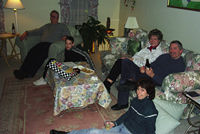 I connected Zenith's L15V26 to an HDV420 set-top box and placed it in the foyer. This TV showed a black-and-white, letterboxed version of the broadcast. Although the L15V26 certainly looks good in color, I decided to show people how HDTV might have looked on monochrome TV sets 40 years ago. Boy, did it draw a crowd during the game.
I connected Zenith's L15V26 to an HDV420 set-top box and placed it in the foyer. This TV showed a black-and-white, letterboxed version of the broadcast. Although the L15V26 certainly looks good in color, I decided to show people how HDTV might have looked on monochrome TV sets 40 years ago. Boy, did it draw a crowd during the game.
The Samsung LTM1575W LCD TV earned the honor of being the bathroom HDTV, and it took signals from another SIR-T150 connected to a second Silver Sensor antenna mounted on the towel rack. The indoor signal from WPVI was quite strong in this location, and the picture quality was better than I expected. In the kitchen, I set up the Mitsubishi LSA820W LCD monitor (which has a 1,280:1,024 HD resolution) and married that to a Samsung SIR-T165 set-top tuner that I placed on top of the refrigerator.
For the family room, I paired the Toshiba 34HF81 widescreen HDTV with an SIR-T165 set-top box. My downstairs theater got to house Sony's VPH-D50HTU CRT projector, Panasonic's TU-DST51A tuner, and a Stewart 82-inch screen.
The pièce de résistance was the temporary theater, which I threw together in my workshop using an old Da-Lite Model B front-projection screen masked off to a 16:9 area that measured about 65 inches diagonally. To the rear of the room, I placed the Optoma HE56 projector atop a ladder and hooked it up to my remaining Zenith HDV420 set-top box. My wife's 17-year-old desktop stereo system came out of storage for audio reinforcement, and I retrieved an area rug from the attic to cover the floor. It was a Spartan accommodation, to be sure; so, as a joke, I placed a sign pointing guests toward Veterans Stadium at the bottom of the basement steps. Little did I know how popular this theater would become during the game.

